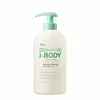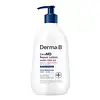What's inside
What's inside
 Key Ingredients
Key Ingredients

 Benefits
Benefits

 Concerns
Concerns

 Ingredients Side-by-side
Ingredients Side-by-side

Water
Skin ConditioningButylene Glycol
HumectantGlycerin
HumectantEthylhexyl Palmitate
EmollientCaprylic/Capric Triglyceride
MaskingPentaerythrityl Stearate/Caprate/Caprylate/Adipate
EmollientTrisiloxane
Skin ConditioningSqualane
EmollientRosa Canina Fruit Oil
EmollientArgania Spinosa Kernel Oil
EmollientSimmondsia Chinensis Seed Oil
EmollientPolyglyceryl-2 Stearate
EmulsifyingPolyglyceryl-3 Distearate
EmulsifyingGlyceryl Stearate Citrate
EmollientGlyceryl Stearate
EmollientSorbitan Stearate
EmulsifyingStearyl Alcohol
EmollientSodium Polyacryloyldimethyl Taurate
Emulsion StabilisingAmmonium Acryloyldimethyltaurate/Vp Copolymer
Trehalose
HumectantPanthenol
Skin ConditioningCetyl Ethylhexanoate
EmollientDipropylene Glycol
HumectantHydrogenated Polydecene
EmollientBifida Ferment Lysate
Skin ConditioningLactobacillus Ferment Lysate
Skin ConditioningStreptococcus Thermophilus Ferment
HumectantPollen Extract
EmollientGlycine Soja Oil Unsaponifiables
EmollientOlea Europaea Oil Unsaponifiables
Skin ConditioningTriticum Vulgare Germ Oil Unsaponifiables
EmollientCarbomer
Emulsion StabilisingTromethamine
BufferingHydrogenated Lecithin
EmulsifyingTrideceth-10
CleansingButyrospermum Parkii Butter
Skin ConditioningCholesterol
EmollientHydrolyzed Hyaluronic Acid
HumectantCeramide NP
Skin ConditioningPalmitic Acid
EmollientStearic Acid
CleansingBeta-Glucan
Skin ConditioningTocopherol
AntioxidantEthylhexylglycerin
Skin ConditioningPentylene Glycol
Skin ConditioningCaprylyl Glycol
EmollientDisodium EDTA
Hydroxyacetophenone
Antioxidant1,2-Hexanediol
Skin ConditioningWater, Butylene Glycol, Glycerin, Ethylhexyl Palmitate, Caprylic/Capric Triglyceride, Pentaerythrityl Stearate/Caprate/Caprylate/Adipate, Trisiloxane, Squalane, Rosa Canina Fruit Oil, Argania Spinosa Kernel Oil, Simmondsia Chinensis Seed Oil, Polyglyceryl-2 Stearate, Polyglyceryl-3 Distearate, Glyceryl Stearate Citrate, Glyceryl Stearate, Sorbitan Stearate, Stearyl Alcohol, Sodium Polyacryloyldimethyl Taurate, Ammonium Acryloyldimethyltaurate/Vp Copolymer, Trehalose, Panthenol, Cetyl Ethylhexanoate, Dipropylene Glycol, Hydrogenated Polydecene, Bifida Ferment Lysate, Lactobacillus Ferment Lysate, Streptococcus Thermophilus Ferment, Pollen Extract, Glycine Soja Oil Unsaponifiables, Olea Europaea Oil Unsaponifiables, Triticum Vulgare Germ Oil Unsaponifiables, Carbomer, Tromethamine, Hydrogenated Lecithin, Trideceth-10, Butyrospermum Parkii Butter, Cholesterol, Hydrolyzed Hyaluronic Acid, Ceramide NP, Palmitic Acid, Stearic Acid, Beta-Glucan, Tocopherol, Ethylhexylglycerin, Pentylene Glycol, Caprylyl Glycol, Disodium EDTA, Hydroxyacetophenone, 1,2-Hexanediol
Water
Skin ConditioningButylene Glycol
HumectantGlycerin
HumectantCaprylic/Capric Triglyceride
MaskingPropanediol
SolventCetearyl Alcohol
EmollientHydrogenated Vegetable Oil
EmollientHydrogenated Polyisobutene
EmollientGlyceryl Stearate
EmollientVinyldimethicone
Ceramide NP
Skin ConditioningPanthenol
Skin ConditioningPolyglyceryl-10 Distearate
EmulsifyingSorbitan Stearate
EmulsifyingLimnanthes Alba Seed Oil
Skin ConditioningPhytosteryl/Isostearyl/Cetyl/Stearyl/Behenyl Dimer Dilinoleate
Skin ConditioningAllantoin
Skin ConditioningHydroxypropyl Methylcellulose
Emulsion StabilisingPotassium Cetyl Phosphate
EmulsifyingDipotassium Glycyrrhizate
HumectantPhenethyl Alcohol
MaskingSodium Hyaluronate
HumectantMethylbenzyl Methylbenzimidazole Piperidinylmethanone
Hydrogenated Lecithin
EmulsifyingOlea Europaea Fruit Oil
MaskingButyrospermum Parkii Butter
Skin ConditioningVitis Vinifera Seed Oil
EmollientCandida Bombicola/Glucose/Methyl Rapeseedate Ferment
AntimicrobialGlycolipids
Skin ConditioningArginine
MaskingCarbomer
Emulsion Stabilising1,2-Hexanediol
Skin ConditioningStearic Acid
CleansingCaprylyl Glycol
EmollientWater, Butylene Glycol, Glycerin, Caprylic/Capric Triglyceride, Propanediol, Cetearyl Alcohol, Hydrogenated Vegetable Oil, Hydrogenated Polyisobutene, Glyceryl Stearate, Vinyldimethicone, Ceramide NP, Panthenol, Polyglyceryl-10 Distearate, Sorbitan Stearate, Limnanthes Alba Seed Oil, Phytosteryl/Isostearyl/Cetyl/Stearyl/Behenyl Dimer Dilinoleate, Allantoin, Hydroxypropyl Methylcellulose, Potassium Cetyl Phosphate, Dipotassium Glycyrrhizate, Phenethyl Alcohol, Sodium Hyaluronate, Methylbenzyl Methylbenzimidazole Piperidinylmethanone, Hydrogenated Lecithin, Olea Europaea Fruit Oil, Butyrospermum Parkii Butter, Vitis Vinifera Seed Oil, Candida Bombicola/Glucose/Methyl Rapeseedate Ferment, Glycolipids, Arginine, Carbomer, 1,2-Hexanediol, Stearic Acid, Caprylyl Glycol
 Reviews
Reviews

Ingredients Explained
These ingredients are found in both products.
Ingredients higher up in an ingredient list are typically present in a larger amount.
1,2-Hexanediol is a synthetic liquid and another multi-functional powerhouse.
It is a:
- Humectant, drawing moisture into the skin
- Emollient, helping to soften skin
- Solvent, dispersing and stabilizing formulas
- Preservative booster, enhancing the antimicrobial activity of other preservatives
Butylene Glycol (or BG) is used within cosmetic products for a few different reasons:
Overall, Butylene Glycol is a safe and well-rounded ingredient that works well with other ingredients.
Though this ingredient works well with most skin types, some people with sensitive skin may experience a reaction such as allergic rashes, closed comedones, or itchiness.
Learn more about Butylene GlycolThis ingredient is also known as shea butter. It is an effective skin hydrator and emollient.
Emollients help soothe and soften your skin. It does this by creating a protective film on your skin. This barrier helps trap moisture and keeps your skin hydrated. Emollients may be effective at treating dry or itchy skin.
Shea butter is rich in antioxidants. Antioxidants help fight free-radicals, or molecules that may harm the body. It is also full of fatty acids including stearic acid and linoleic acid. These acids help replenish the skin and keep skin moisturized.
While Shea Butter has an SPF rating of about 3-4, it is not a sunscreen replacement.
Shea butter may not be fungal acne safe. We recommend speaking with a professional if you have any concerns.
Learn more about Butyrospermum Parkii ButterThis ingredient is an emollient, solvent, and texture enhancer. It is considered a skin-softener by helping the skin prevent moisture loss.
It helps thicken a product's formula and makes it easier to spread by dissolving clumping compounds.
Caprylic Triglyceride is made by combining glycerin with coconut oil, forming a clear liquid.
While there is an assumption Caprylic Triglyceride can clog pores due to it being derived from coconut oil, there is no research supporting this.
Learn more about Caprylic/Capric TriglycerideCaprylyl Glycol is a humectant and emollient, meaning it attracts and preserves moisture.
It is a common ingredient in many products, especially those designed to hydrate skin. The primary benefits are retaining moisture, skin softening, and promoting a healthy skin barrier.
Though Caprylyl Glycol is an alcohol derived from fatty acids, it is not the kind that can dry out skin.
This ingredient is also used as a preservative to extend the life of products. It has slight antimicrobial properties.
Learn more about Caprylyl GlycolCarbomer is a polymer of acrylic acid. Its main role is to create a gel consistency.
A high amount of carbomer can cause pilling or balling up of products. Don't worry, most products contain 1% or less of carbomer.
Ceramide NP is a type of ceramide and formally known as ceramide 3.
Ceramides are intercellular lipids naturally found in our skin that bonds dead skin cells together to create a barrier. They are known for their ability to hold water and thus are a great ingredient for dry skin.
Ceramides are an important building block for our skin barrier. A stronger barrier helps the skin look more firm and hydrated. By bolstering the skin ceramides act as a barrier against irritating ingredients. This can help with inflammation as well.
If you would like to eat ceramides, sweet potatoes contain a small amount.
Read more about other common types of ceramides here:
Ceramide AP
Ceramide EOP
Glycerin is already naturally found in your skin. It helps moisturize and protect your skin.
A study from 2016 found glycerin to be more effective as a humectant than AHAs and hyaluronic acid.
As a humectant, it helps the skin stay hydrated by pulling moisture to your skin. The low molecular weight of glycerin allows it to pull moisture into the deeper layers of your skin.
Hydrated skin improves your skin barrier; Your skin barrier helps protect against irritants and bacteria.
Glycerin has also been found to have antimicrobial and antiviral properties. Due to these properties, glycerin is often used in wound and burn treatments.
In cosmetics, glycerin is usually derived from plants such as soybean or palm. However, it can also be sourced from animals, such as tallow or animal fat.
This ingredient is organic, colorless, odorless, and non-toxic.
Glycerin is the name for this ingredient in American English. British English uses Glycerol/Glycerine.
Learn more about GlycerinGlyceryl Stearate is a mix of glycerin and stearic acid.
It is used to stabilize the mixing of water and oil ingredients. By preventing these ingredients from separating, it can help elongate shelf life. It can also help thicken the product's texture.
As an emollient, it helps soften skin and supports barrier-replenishing ingredients.
In cosmetics, Glyceryl Stearate is often made from vegetable oils or synthetically produced.
This ingredient may not be fungal-acne safe
Fun fact: The human body also creates Glyceryl Stearate naturally.
Learn more about Glyceryl StearateHydrogenated Lecithin is created from the hydrogenation of lecithin (a group of phospholipids). Hydrogenation is a chemical reaction between hydrogen and another element.
This ingredient is an emollient and emulsifier. As an emollient, it helps soften skin by trapping moisture within. As an emulsifier, it prevents oil and water ingredients from separating.
Panthenol is a common ingredient that helps hydrate and soothe the skin. It is found naturally in our skin and hair.
There are two forms of panthenol: D and L.
D-panthenol is also known as dexpanthenol. Most cosmetics use dexpanthenol or a mixture of D and L-panthenol.
Panthenol is famous due to its ability to go deeper into the skin's layers. Using this ingredient has numerous pros (and no cons):
Like hyaluronic acid, panthenol is a humectant. Humectants are able to bind and hold large amounts of water to keep skin hydrated.
This ingredient works well for wound healing. It works by increasing tissue in the wound and helps close open wounds.
Once oxidized, panthenol converts to pantothenic acid. Panthothenic acid is found in all living cells.
This ingredient is also referred to as pro-vitamin B5.
Learn more about PanthenolSorbitan Stearate comes from sorbitol and stearic acid. Sorbitol is a type of sugar and stearic acid is a fatty acid.
It is used as an emulsifier and helps ingredients stay together by creating water-in-oil emulsions.
This ingredient may not be Malassezia folliculitis, or fungal-acne safe.
Stearic Acid is a fatty acid. It is an emollient, emulsifier, and texture enhancer.
As an emollient, stearic acid helps soften skin. It aids the skin's protective barrier by preventing water loss. It also provides a gentle cleansing effect without stripping away natural oils.
Stearic acid may also be used to enhance the texture of products. It can add volume and stabilize ingredients such as water and oil. This can help water and oil ingredients from separating.
Sources of stearic acid include animal or vegetable fats/oils such as coconut or shea. It can be naturally found in butter, cocoa butter, shea butter, vegetable fats, and animal tallow.
This ingredient may not be Malassezia folliculitis, or fungal-acne safe.
Learn more about Stearic AcidWater. It's the most common cosmetic ingredient of all. You'll usually see it at the top of ingredient lists, meaning that it makes up the largest part of the product.
So why is it so popular? Water most often acts as a solvent - this means that it helps dissolve other ingredients into the formulation.
You'll also recognize water as that liquid we all need to stay alive. If you see this, drink a glass of water. Stay hydrated!
Learn more about Water